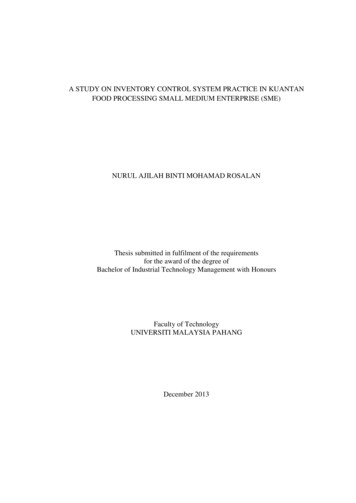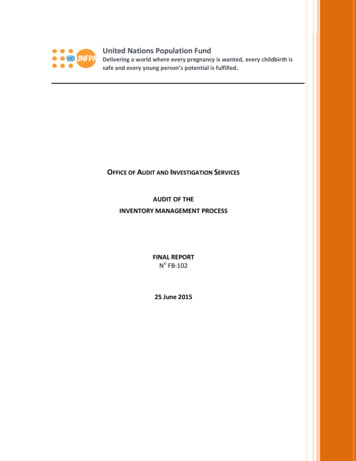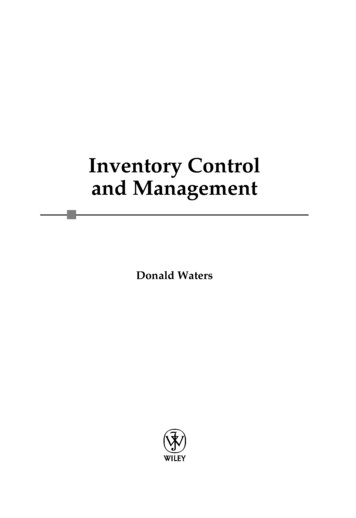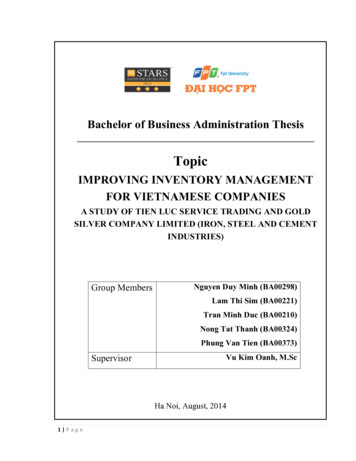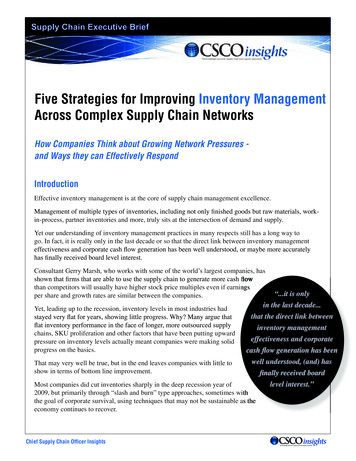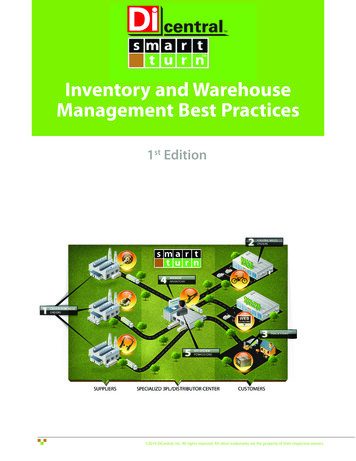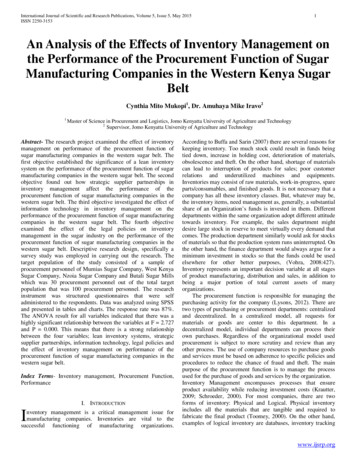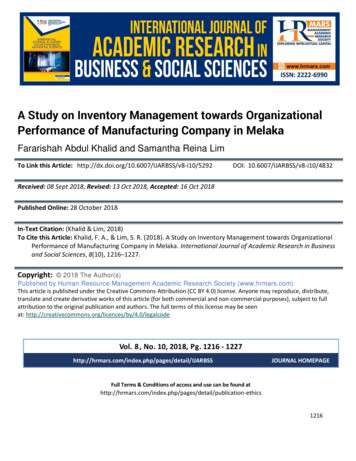
Transcription
International Journal of Academic Research in Business and Social SciencesVol. 8 , No. 10, Oct. 2018, E-ISSN: 2 22 2 -6990 2018 HRMARSA Study on Inventory Management towards OrganizationalPerformance of Manufacturing Company in MelakaFararishah Abdul Khalid and Samantha Reina LimTo Link this Article: http://dx.doi.org/10.6007/IJARBSS/v8-i10/5292DOI: 10.6007/IJARBSS/v8-i10/4832Received: 08 Sept 2018, Revised: 13 Oct 2018, Accepted: 16 Oct 2018Published Online: 28 October 2018In-Text Citation: (Khalid & Lim, 2018)To Cite this Article: Khalid, F. A., & Lim, S. R. (2018). A Study on Inventory Management towards OrganizationalPerformance of Manufacturing Company in Melaka. International Journal of Academic Research in Businessand Social Sciences, 8(10), 1216–1227.Copyright: 2018 The Author(s)Published by Human Resource Management Academic Research Society (www.hrmars.com)This article is published under the Creative Commons Attribution (CC BY 4.0) license. Anyone may reproduce, distribute,translate and create derivative works of this article (for both commercial and non-commercial purposes), subject to fullattribution to the original publication and authors. The full terms of this license may be seenat: deVol. 8, No. 10, 2018, Pg. 1216 - SSJOURNAL HOMEPAGEFull Terms & Conditions of access and use can be found tion-ethics1216
International Journal of Academic Research in Business and Social SciencesVol. 8 , No. 10, Oct. 2018, E-ISSN: 2 22 2 -6990 2018 HRMARSA Study on Inventory Management towardsOrganizational Performance of ManufacturingCompany in MelakaFararishah Abdul Khalid1 and Samantha Reina Lim21,2Faculty of Technology Management and Technopreneurship, Universiti Teknikal Malaysia MelakaMalaysiaAbstractInventory exists in almost every organization, it is crucial for an organization to have goodunderstanding and strategy about inventory management. Inventory management has significancefor an enterprise in an inventory intensive manufacturing industry (Rajeev, 2008). In this research,the researcher aimed to know the relationship between inventory management and organizationalperformance of manufacturing company in Melaka. Thus, the researchers identified three inventorymanagement strategies, Vendor Managed Inventory (VMI), Material Requirement Planning (MRP),and Just-In-Time (JIT), as the independent variables to investigate the research questions. In order tocollect the data and information needed, the researcher used qualitative method as the researchmethodology. The interviewee is aimed to be the inventory management manager of the targetcompany. The data analysis will be using a deductive approach where all interview questions will beconstructed based on the research questions, research objectives and conceptual framework. Afterthe interview is conducted, the researcher will transcribe the script and start analysing based on theanswer given by the interviewee.Keywords: Inventory Management, Inventory Management Strategy, JIT, VMI, MRP, OrganizationalPerformanceIntroductionInventory exists in most of the organization, especially for manufacturing company it acts as asignificant amount of current assets. As inventory plays a critical role to an organization, inaccuraciesin an inventory will cause the organization to have chain problem, including loss or poor productivity,manufacture of excessive outcomes, reduction of customer loyalty, accumulation of overpricinginventory and etc. There is a trend showing that the manufacturing industry has been in rapid growthsince the year 2016, and the trend is believed to continue for few more years. The growth in advancetechnology and innovation is also one of the potential factors that lead to the increased productivity1217
International Journal of Academic Research in Business and Social SciencesVol. 8 , No. 10, Oct. 2018, E-ISSN: 2 22 2 -6990 2018 HRMARSin the industry. Inventory is defined as a list of goods and materials which are available in stock forbusiness (Sharma, 2016). Statistical tests show that perceived improvements in organizationalperformance are associated with improvements in supply chain quality management practices (ChuHua Kuei, 2001). High levels of inventory held in stock affect adversely the procurement performanceout of the capital being held which affects cash flow leading to reduced efficiency, effectiveness anddistorted functionality (Koin Violet Resia, 2014). The main purpose of this research is to investigatethe relationship between inventory management and organization performance. Focusing on howinventory management can bring impact to the performance of an organization, the research goes indepth to the strategies of inventory management analyzing its pros and cons. This research is thestudy of inventory management towards organizational performance in Melaka. In this particularstudy, the research outlines the inventory strategy that potentially affects the organizationperformance. Based on different organization, the strategy, and technique used to manage inventoryvarious. It identifies the relationship between inventory management and organizationalperformance, experimenting whether there is a positive relationship between both variables.Theoretical BackgroundInventory ManagementThe inventory itself has many definitions according to different people and party, top managementuses different terms as well to describe the same idea. An inventory is actually a list of the items heldin stock, but many people use it to mean both the list of items and the stocks themselves (Waters,2017). As stated by Ballou (2004), inventory can be defined as the supply of raw materials, suppliers,work-in-progress, components, and finished goods that appear at numerous points throughout afirm’s production and logistics process. Inventory is defined as a list of goods and materials which areavailable in stock for business and in accounting inventory is considered as an asset (A. Sharma, 2016).An inventory managers goal, for example, is modeled as minimizing cost or maximizing profit whilesatisfying customers’ demands (Koumanakos, 2008). Inventory management is always aboutoptimizing the inventory to achieve good firm performance, increase, and effectiveness and increaseefficiency. Poor inventory management in production floor will cause excess or shortages of rawmaterial which indirectly impact business performance of the company (Ooi, 2017). Management ofperishable inventories is an important issue due to the need of satisfying unpredictable consumers’demand with limited supplier capabilities and storage space (Latosinski, 2017). Justified by Angel(2014), an effective inventory management must consist of six main criteria, make sure that there isan uninterrupted supply of raw materials to enable uninterrupted production process, keep enoughfinished manufactured goods for uninterrupted sales transactions and proficient service tocustomers, reduce the holding cost and period, manage assets and keep it at the best level, allowimproved utilization of on hand stocks by simplifying interdepartmental handovers within a companyand lastly keep enough stocks of raw materials in periods of shortage in supply and expected priceincreases.Vendor Managed Inventory (VMI)Vendor Managed Inventory (VMI) is an inbound logistics strategy based on the concept that thesupplier should be in charge of management customer’s inventories by using the demandinformation provided by the customer (Hall, 2001). VMI is also known as consignment inventory on1218
International Journal of Academic Research in Business and Social SciencesVol. 8 , No. 10, Oct. 2018, E-ISSN: 2 22 2 -6990 2018 HRMARSother occasions, has been widely used in various industries (Yan Dong, 2002). The retailer or firmprovides the vendor with access to its real-time inventory level, in which this partnership programthe former may set certain servic-level or shelf-space requirements which are then taken intoconsideration by the vendor (Sari, 2007). Typical information sharing practices include sharing ofpoint of sales date, demand, sales orders, inventory status, order fulfillment status and productionschedules, which can help inventory management to reduce inventory cost and improve decisionmaking capability (Nachiappan, 2005).Material Requirement Planning (MRP)Material Requirements Planning (MRP) is a production planning and inventory control system whichhave three main functions: (i) the system helps ensure that the appropriate materials are availablefor production and necessary products are available for customers to avoid shortage, (ii) reduceswaste by maintaining only the lowest possible materials and product levels in stock, (iii) helps planmanufacturing functions, delivery schedules and purchasing (Rouse, 2014). MRP implies that for eachend item a master production schedule is created, specifying delivery times and order quantities froma forecasted demand and when the inventory position of the item is less than the defined level, anew replenishment starts for the item through a purchase or manufacturing process (Segerstedt,2006). The aim of inventory management is to establish a link between the entire production anddistribution channels of product or service in order to confirm or satisfy customer requirements (Chu,2001). With the help of MRP system, the company is able the estimate better in delivering productsto customers, which will enhance company performance in long-term.Just-in-time (JIT)Just-in-time (JIT) was originally introduced by the Japanese back in the 1930s as one of the newestapproaches in that era but was quickly adapted and practiced by organizations all over the world. JIThas been developed, because, beyond the act of an inventory control method, and it is a philosophy,the philosophy used in the production of, and seeks to remove all the waste of resources (Rahmani,2014). The achievement of JIT main goals brings key point benefits, which are an elimination ofinventories will enable the organization to control the ordering and delivering a process for meetingthe production orders and organization’s flexibility, and eliminating of inventories results to very lowinventory carrying costs for the organization (Nemtajela, 2016). Companies applying JIT productionsystem aim at minimizing all inventory levels and delivering the goods and services to customers ontime (Salehi, 2010).Organizational PerformanceAchieving improvement or excellent in performance is one of the most important aspects to fight for.Singh et al. (2010) identified supply chain practice such as inventory management has an impact onorganizational performance. Organizational performance can be measured in terms of two differentperspectives, which are financial and non-financial. The organizational performance that thisresearch will discuss is the aspect of non-financial measurement. Roth and Miller (1992) emphasizethat business performance can be measured by manufacturing capabilities: (Ward et al., 1996)quality, cost, dependability, flexibility, and innovation. Manufacturing strategy literature typically1219
International Journal of Academic Research in Business and Social SciencesVol. 8 , No. 10, Oct. 2018, E-ISSN: 2 22 2 -6990 2018 HRMARSdefines competitive capabilities in term of quality, delivery, flexibility, and cost attributes (Roth,1991). Competitive capabilities refer to the firm’s ability to provide products with certainperformance, which can win orders from competitors (Antonio, 2007). A poor or fail inventorymanagement will contribute to a negative implication of system integration on firm’s operationalperformance in terms of flexibility, delivery, cost and quality (Sambasivan, 2011). A flexible inventorycontrol management is an important approach to achieving organizational performance (Ogbo,2014).Vickery (1997) and Antonio (2007) has stated few definitions for the term quality, delivery, flexibility,and cost; the definitions are as below:1. Flexibility: The ability to rapidly adjust capacity so as to accelerate or decelerate productionin response to changes in customer demand (responsiveness), reduce waste and delays.2. Low Cost: The ability to minimize the total cost of production (inclusive of labor, materials,and operating costs) through efficient operations, process technology and/or scaleeconomies.3. Delivery Dependability: The ability to exactly meet quoted or anticipated delivery dates andquantities, and deliver quicker than competitors.4. Quality (Conformance to Specification): The ability to manufacture a product whose operatingcharacteristics meet established performance standards and reliability.Theoretical FrameworkFigure 1: The conceptual framework of the study on inventory management (Vendor ManagedInventory, Material Requirement Planning, Just-In-Time) that bring impact to the organizationalperformanceMethodology1220
International Journal of Academic Research in Business and Social SciencesVol. 8 , No. 10, Oct. 2018, E-ISSN: 2 22 2 -6990 2018 HRMARSThis research aims to identify: (i) the inventory management strategy towards organizationalperformance, (ii) the relationship between inventory management strategy and organizationalperformance, and (iii) the most significant inventory management strategy towards organizationalperformance. In order to investigate three objectives, the respondent is required to be someone fromthe top management or is in charge of inventory as they have better understanding of the companyoverall performance and is able to access the big picture. Since the amount of potential respondentsis constraint, and the research requires more meanings expressed through words to have betterunderstanding on the results, thus researcher chooses to use qualitative method.In this research, the researcher will go for non- standardised approach by using semi-structuredinterviews. In semi-structured interviews the researcher has a list of themes and possibly some keyquestions to be covered (Saunders, 2012). The questions listed might be slightly different accordingto different interviewee, as the interview is conducted the sequence of questions to be asked mightas well be different. This research will adapt judgmental sampling in selecting respondent.Judgemental sampling is also known as purposive sampling, researcher use judgement to selecttarget company that will best enable to answer the research questions and meet research objectives(Saunders, 2012). In this research only respondents who are dealing directly with inventorymanagement and at the same time have the access to organizational performance will be selected.Thus, the respondent will be an inventory management manager or logistics manager. As qualitativeresearch requires respondents to provide answer either through verbal or written form, it is crucialfor the researcher to be able to interpret the main information. As mentioned by Saunders et al(2016), the task of transcribing an audio-recording is extremely time-consuming. Thus, when it comesto transcribing the interview, the researcher needs to be able to only highlight out the important andrelated parts. In the transcript the researcher needs to distinguish between interviewer and theinterviewee and between questions and responses (Saunders, 2016).DiscussionThe most common answer received is that the respondents company is currently applying MRP, VMI,JIT in their daily operation to deal with different type of inventory. The inventory strategy is choosenbased on real time situation as each inventory is suitable for different commodity. Some companyare still using traditional inventory management strategy but has also bit by bit integrating to the newtype of strategy as the market changes too rapidly. Smaller company tends to adopt lesser inventorymanagement strategy whereas large organization will have multiple inventory management strategyto deal with their different type and over loaded commodity.MRP is more like the inventory controller keys in important data or related data to enables the systemto calculate future purchase of the material. Based on the requirement of different company thethings to be factored in various as it needs to tie back to the organizational objectives and goals. VMIis a strategy where host company shares material usage information to the third party, vendor toenables the latter helps to make decision on the purchase of inventory or raw material. The strategylighten the burdern of huge organization as the inventory needed to deal is in huge amount, allowingvendor to help make decision in certain commodity enhance the company overall performance andflexibility as well. Trust and good relationship is build among the organization and vendor which is animportant factor for long term relationship. JIT concept is ordering the material when and only is1221
International Journal of Academic Research in Business and Social SciencesVol. 8 , No. 10, Oct. 2018, E-ISSN: 2 22 2 -6990 2018 HRMARSneeded. The organization or plant will not store excessive material for future usage. Agreement withvendor is made where they will deliver the material on a daily or weekly basis. The purpose ofapplying JIT is to ensure the factory has more space for other critical material.Traditional inventory management strategy is time consuming and costly. It will lead to inefectiveand other negative impacts that will cause the organization to loss competitive advantages. Lessfactor is consider when making decision, which leads to many unseen problem in the future andcontroller need to solve many unnecessary problem to cover the mistake made in the first place.Traditional inventory mangement strategy is difficult to capture a sudden change or ramp in thedemand usage, thus it will cause the factory or company to have problem loading materials toproduction line which will even cause lines down if is not deal on time. Inaccurate of usage data thatorigins by using the historical data is also one of the cons of the traditional inventory management asit does not have a forecast of the future but relies only on past data records.As the company productivity runs low and become less effective due to the not up-to-date inventorymanagement startegy, the organization top management decided to abandoned the traditionalstrategy and adopt the new inventory management strategy. When the market has already advancedinto a new era, one must be also change to make himself capable to compete and communicate withothers in the market. It is important for organization to be able to cope with the rapid change oftechnology, thus changing to a new inventory management strategy enhance the adaption. As thecompany is expanding and improving, there will be many limitation such as storage space,consumption level, cost and etc, by adopting a suitable inventory management strartegy, it canenhance the progress and enables the organization to operate effectively and effieciently.From the answers of respondents, they agreed that there is a relationship between inventorymanagement strategy and organizational performance. As organizational performance can bemeasured by the organization capabilities which are delivery, flexibiliy, cost and quality, the inventorymanagement will also give impact on these four criteria if is not handled well. There is a linkagebetween both the strategy and the performance, when there is good strategy that suits theorganization and meets the objective it will eventually lead to improvement of performance.There is always risk when changing or adopting new strategy, the integration period is hard and toughbut if the organization passed through the hardship, it will see a bright future awaits them. Bychanging from traditional to new inventory management strategy, there is improvement in theorganizational performance as the
inventory management can bring impact to the performance of an organization, the research goes in depth to the strategies of inventory management analyzing its pros and cons. This research is the . performance in terms of flexibility, delivery, cost and quality




